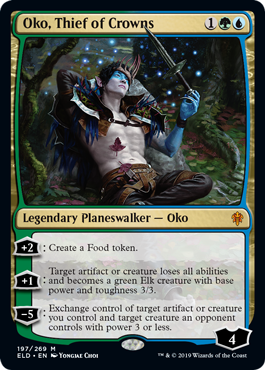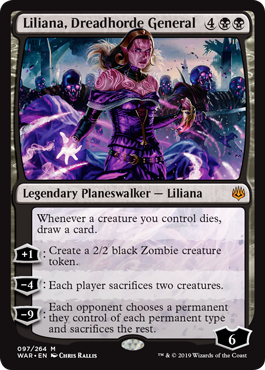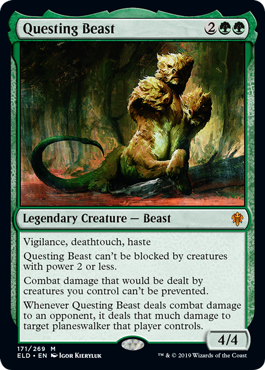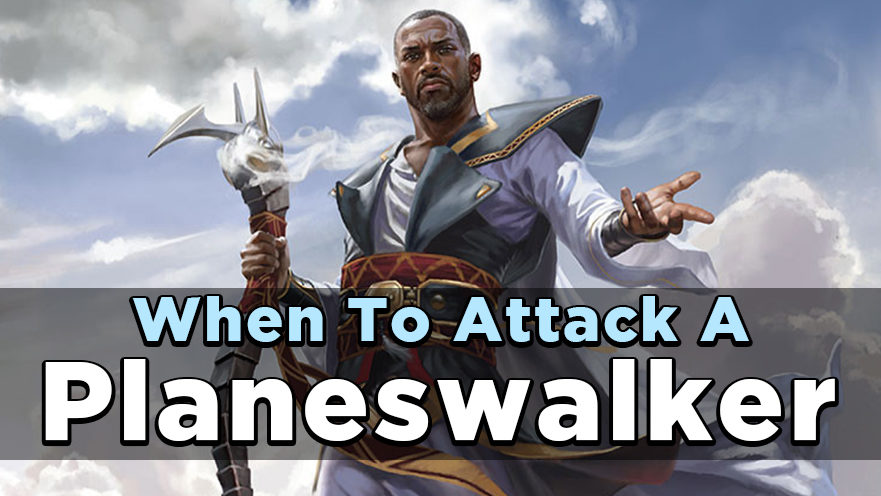Planeswalkers have played a powerful role in the Standard metagame for years; since the release of War of the Spark, there are more Planeswalkers in Standard than ever before. Their presence forces players to make an important choice: when is it appropriate to attack the Planeswalker, and when should you attack its controller instead?
Attacking a Planeswalker reduces its loyalty total, which reduces how much it can affect the board state. But it also reduces the resources you have available to kill your opponent, which is the primary goal of any game of Magic. Here are some tips for how to decide who to attack.
When to Attack a Planeswalker

The best time to attack a Planeswalker is when its abilities are critical to your opponent’s strategy. Oko, Thief of Crowns was a great example of this. He could quickly generate a lot of Food tokens – maybe to power up Tezzeret, Master of the Bridge‘s damage-dealing ability, or to turn into Elk to attack with, or just to gain lots of life. He could also neutralize opposing threats by turning them into Elk. Getting him off the table quickly, before he could do a great deal of harm, was essential.
When you’re attacking planeswalkers, timing can be key. Oko was a great example of a planeswalker that you wanted off the table as soon as possible; Jace, Wielder of Mysteries is one that requires a little more strategy. His static ability gives his controller an alternate win condition should they run out of cards. If you wait to kill him until your opponent has few enough cards remaining in their library, they can lose to their own mill strategy.

You should also attack Planeswalkers whose abilities disrupt your own strategy. For example, Liliana, Dreadhorde General can make a lot of blockers fairly quickly, leaving creature-based strategies in trouble. Teferi, Time Raveler prevents opponents from casting spells at instant speed, so if your strategy relies on instants or spells with Flash, you need to get him out of the way quickly.
Planeswalkers with powerful ultimate abilities, like Vraska, Golgari Queen‘s emblem, are less urgent to get rid of. If your opponent is relying on the ultimate to win the game, and you can deal with the effects of their Planeswalker’s plus ability, you only have to attack them once in a while to prevent them from reaching the loyalty count they need.
When to Attack Your Opponent

Sometimes, it’s best to attack your opponent, even if they have a powerful Planeswalker in play. The most important of these situations is when you can do lethal damage. You won’t have to worry about your opponent’s Planeswalkers when you’ve already won the game.
You might also want to attack the opponent instead of their Planeswalker when you have creatures that benefit from dealing combat damage to an opponent, such as Questing Beast or Atemsis, All-Seeing. Questing Beast even kills two birds with one stone, damaging your opponents’ Planeswalkers every time it deals damage to your opponent.
You should also attack your opponent if their Planeswalkers aren’t a major threat to you or a major benefit to your opponent. For example, Kasmina, Enigmatic Mentor isn’t much of a threat if your strategy relies more on you buffing your creatures than damaging theirs; and Vivien, Arkbow Ranger isn’t particularly useful to your opponent if they’re having trouble finding creatures or you have ways to destroy those creatures. If your opponent is using uncommon Planeswalkers from War of the Spark, you’ll often be able to attack until they have less loyalty than they need to use their ability, and then decide whether their static ability affects you enough to spend resources on killing them.
Doing the Combat Math
Deciding whether to attack a Planeswalker or its controller is not a simple or straightforward choice. The optimal answer may be different every game, and adding more Planeswalkers to the board changes the calculation. The most important thing is to be aware of your opponents’ life total and their Planeswalkers’ loyalty totals, and to understand how each Planeswalker affects the board.

Alex is an Azorius bureaucrat who dreams of joining the Selesnya Conclave. Their favorite color of mana is green, and they love brewing for Commander variants.

